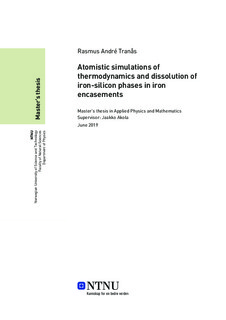| dc.contributor.advisor | Akola, Jaakko | |
| dc.contributor.author | Tranås, Rasmus André | |
| dc.date.accessioned | 2019-10-29T15:00:57Z | |
| dc.date.available | 2019-10-29T15:00:57Z | |
| dc.date.issued | 2019 | |
| dc.identifier.uri | http://hdl.handle.net/11250/2625264 | |
| dc.description.abstract | Målet med denne masteroppgaven er å bruke tetthets-funksjonal-teori sammen med en cluster-ekspansjons-metode, slik at jern-silisium legeringer på et statisk kubisk romsentrert gitter kan bli studert ved bruk av Monte Carlo-simuleringer i det kanoniske og semi-store-kanoniske ensemblet.
Tetthets-funksjonal-teori beregningene er gjort med GPAW, og utveksling-korrelasjons funksjonalen brukt er Perdew-Burke-Ernzerhof funksjonalen.
Flere beregnede material-egenskaper til jern og silisium er presentert. Dette fremhever mulighetene med tetthets-funksjonal-teori beregninger.
To jern-silisium-strukturer med silisium-konsentrasjoner på 25 % og 50 % er funnet ved hjelp av Monte Carlo simulert nedkjøling.
Et fenomen studert i denne oppgaven er dissolusjonen av kuber og oktaeder laget av de to ovennevnte fasene plassert i en ren jern-fase.
Det er vist at det, i det generelle tilfellet, kreves høyere temperaturer for å dissolvere 50 % av silisium-atomene i den interne strukturen hvis strukturen er konstruert som en kube i stedet for et oktaeder.
FeSi-fasen er funnet å motstå høyere temperaturer enn Fe3Si-fasen før silisium-atomer dissolverer i den omringende jern-fasen.
Fase-grense-søk er gjort for lave silisium-konsentrasjoner, som igjen viser at det eksisterer et temperatur- og konsentrasjons-domene hvor bcc Fe3Si-fasen og den rene jern-fasen eksisterer sammen.
Overflateenergien assosiert med et sjikt mellom Fe3Si- og jern-fasen er funnet til å være 99.96 mJ/m}^2.
Dette resultatet ble funnet ved å bruke tetthets-funksjonal-teori-beregninger med skive-strukturer. | |
| dc.description.abstract | The aim of this Master's thesis is to use density functional theory calculations together with a cluster expansion method, in such a way that
iron-silicon alloys on a fixed body-centered cubic lattice can be studied using Monte Carlo simulations in the
canonical and semi-grand canonical ensemble. The density functional
theory calculations are done using GPAW, and the exchange-correlation
functional used is the Perdew-Burke-Ernzerhof functional.
Several calculated material properties of iron and silicon are presented, highlighting the capability of density functional theory calculations.
Two iron-silicon phases with silicon concentrations of 25 % and 50 %
are obtained using Monte Carlo simulated annealing. A phenomenon studied in this thesis is the atomic dissolution of cubes and octahedra, made of the two phases mentioned above, encapsulated in a pure iron phase. It is
shown that, in general, higher temperatures are needed to dissolute 50 % of the silicon
atoms in the internal structures if the structures are constructed as cubes, as
opposed to octahedra. The FeSi phase is found to withstand higher temperatures than the Fe3Si phase before silicon atoms dissolve into the iron surroundings.
Phase boundary tracing is done for low silicon concentrations, showing
that there is a temperature and concentration range within which
the bcc Fe3Si and pure iron phases co-exist.
The surface energy associated with the intersect between the Fe3Si and pure
iron phases is found to be 99.96 mJ/m^2. This result is obtained
from density functional theory calculations with slab structures. | |
| dc.language | eng | |
| dc.publisher | NTNU | |
| dc.title | Atomistic simulations of thermodynamics and dissolution of iron-silicon phases in iron encasements | |
| dc.type | Master thesis | |
